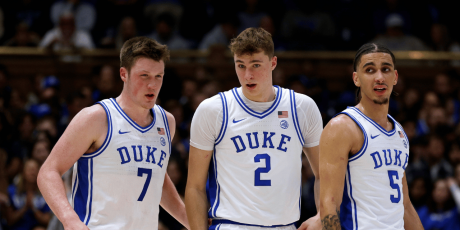How Effective Will Marshawn Lynch Be in 2017?

When we last saw Marshawn Lynch on the football field, he was struggling through an injury-plagued age-29 season in Seattle. He averaged 17.7 touches for 71 yards and 0.43 touchdowns, or 11.5 fantasy points (PPR) per game. That was the 28th-highest per game average that year, so he was playing at a fantasy RB3 pace. He had a 3.76 YPC, which was a good bit lower than his career 4.41 YPC after joining the Seahawks.
Then he “retired,” which actually turned out to be a year-long sabbatical, and he’s now back with his hometown Oakland Raiders on a two-year deal. It’s a savvy move for the soon-to-be Las Vegas Raiders to sign a local star who can put butts in the seats while the team plans its departure from the Bay Area.
But what sort of season can we reasonably expect from a now 31-year-old who spent a year away from football and wasn’t all that effective the last time we saw him play?
Comparables
One way to answer that question is to look at his comparables. Below you’ll find a table of the 21 running backs who carried the ball at least 600 times from age 27 to age 29, rushed for at least 2,500 yards and played (at least) through their age 31 season. (I also filtered out those players who didn’t start at least 50% of their games played in their age 31 season, since we’re expecting Lynch to start for the Raiders if he’s healthy enough to play.)
| Player | G | Att | Yds | YPC | TD | Y/G |
|---|---|---|---|---|---|---|
| Curtis Martin | 16 | 371 | 1697 | 4.57 | 12 | 106.1 |
| Tiki Barber | 16 | 327 | 1662 | 5.08 | 5 | 103.9 |
| Thomas Jones | 16 | 331 | 1402 | 4.24 | 14 | 87.6 |
| Ricky Watters | 16 | 278 | 1242 | 4.47 | 7 | 77.6 |
| Emmitt Smith | 16 | 294 | 1203 | 4.09 | 9 | 75.2 |
| Fred Taylor | 15 | 223 | 1202 | 5.39 | 5 | 80.1 |
| Warrick Dunn | 16 | 286 | 1140 | 3.99 | 4 | 71.3 |
| Frank Gore | 16 | 255 | 1106 | 4.34 | 4 | 69.1 |
| LaDainian Tomlinson | 15 | 219 | 914 | 4.17 | 6 | 60.9 |
| Terry Allen | 16 | 254 | 896 | 3.53 | 8 | 56.0 |
| Priest Holmes | 8 | 196 | 892 | 4.55 | 14 | 111.5 |
| Matt Forte | 14 | 218 | 813 | 3.73 | 7 | 58.1 |
| Jerome Bettis | 16 | 246 | 811 | 3.30 | 7 | 50.7 |
| Marshall Faulk | 14 | 195 | 774 | 3.97 | 3 | 55.3 |
| Corey Dillon | 12 | 209 | 733 | 3.51 | 12 | 61.1 |
| Steven Jackson | 15 | 190 | 707 | 3.72 | 6 | 47.1 |
| Thurman Thomas | 16 | 154 | 643 | 4.18 | 1 | 40.2 |
| Charlie Garner | 14 | 120 | 553 | 4.61 | 3 | 39.5 |
| Stephen Davis | 13 | 180 | 549 | 3.05 | 12 | 42.2 |
| Eddie George | 13 | 132 | 432 | 3.27 | 4 | 33.2 |
| Adrian Peterson | 3 | 37 | 72 | 1.95 | 0 | 24.0 |
Here’s summary of how those backs performed from age 27-29 compared to what they produced in their age 31 season.
| Group | G | Att | Yds | YPC | TD |
|---|---|---|---|---|---|
| Age 27-29 | 14.9 | 18.8 | 79.7 | 4.23 | 0.54 |
| Age 31 | 14.1 | 15.9 | 65.7 | 4.12 | 0.48 |
| % Drop | 5% | 15% | 18% | 3% | 11% |
These 21 backs experienced, on average, a five percent drop in games played, a 15 percent drop in rushing attempts per game, an 18 percent drop in rushing yards per game, a three percent drop in YPC, and an 11 percent drop in touchdowns per game.
Applying these reductions to Lynch’s age 27-29 averages, we get the following projections:
| Player | G | Att | Yds | YPC | TD | Y/G |
|---|---|---|---|---|---|---|
| Marshawn Lynch | 12.3 | 195 | 819 | 4.19 | 7.9 | 66.6 |
Lynch was one of the less durable backs in the study during his age 27-29 seasons, thanks to his nine missed games in 2016, so his games played projection lands at 12.3. Staying healthy will be key.
Current Projections
You’ll notice that our current projections (225 carries, 859 yards, 9.5 touchdowns) are a bit more bullish about Lynch’s overall rushing production. I like the landing spot in Oakland, where there’s an excellent offensive line in place, along with a quality passing game that is capable of taking the pressure off of Lynch to carry the offense.
I also believe that the year off could lead to better overall health since his body wasn’t taking a beating in 2016. Instead, it was recovering from a tough 2015 season.
On the flip side, there's also the argument that Lynch can’t possibly be in “football shape,” so staying healthy throughout the offseason programs (to get the necessary reps) would be great for his overall outlook.
The Bottom Line
Lynch is currently going with the 44th pick in the 4th round of MFL10 (12-team PPR) drafts, which seems reasonable given the other running backs – Joe Mixon, Isaiah Crowell, Carlos Hyde, Dalvin Cook, Mark Ingram and Tevin Coleman – going at about the same point in early drafts.
Considering his likely backup, DeAndre Washington, isn’t being drafted inside the top 60 running backs, it looks like this is a pretty cheap running game to buy into. (Note: Jalen Richard is also in the mix, but I think Washington’s college career better prepared him for a 12-carry role if Lynch were to miss time. Washington out-carried Richard by a margin of 26-to-15 in the three games that Murray either missed or was limited.) If I could only draft one of the Oakland running backs, it would be Washington, due to his relative cost.
Prospective Lynch owners should expect two to four missed games when putting together their teams. Age 31 running backs tend to miss an extra game when compared to their more youthful counterparts and Lynch’s injury struggles in 2015 aren’t particularly encouraging.
But when he plays, he should carry the load (14-16 carries per game, a bit more than what Latavius Murray saw in his 13 relatively healthy games). Double-digit touchdowns are a distinct possibility, given the quality of Oakland’s offense and Lynch’s ability to punch it into the end zone.


















